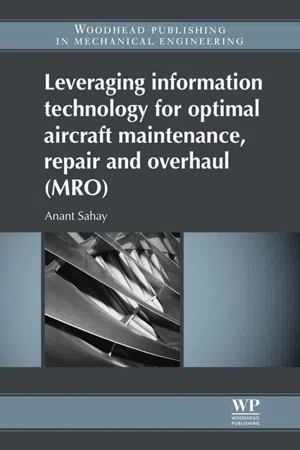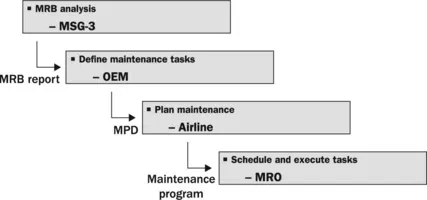
eBook - ePub
Leveraging Information Technology for Optimal Aircraft Maintenance, Repair and Overhaul (MRO)
- 282 pages
- English
- ePUB (mobile friendly)
- Available on iOS & Android
eBook - ePub
Leveraging Information Technology for Optimal Aircraft Maintenance, Repair and Overhaul (MRO)
About this book
Aircraft maintenance, repair and overhaul (MRO) requires unique information technology to meet the challenges set by today's aviation industry. How do IT services relate to aircraft MRO, and how may IT be leveraged in the future?Leveraging Information Technology for Optimal Aircraft Maintenance, Repair and Overhaul (MRO) responds to these questions, and describes the background of current trends in the industry, where airlines are tending to retain aircraft longer on the one hand, and rapidly introducing new genres of aircraft such as the A380 and B787, on the other. This book provides industry professionals and students of aviation MRO with the necessary principles, approaches and tools to respond effectively and efficiently to the constant development of new technologies, both in general and within the aviation MRO profession. This book is designed as a primer on IT services for aircraft engineering professionals and a handbook for IT professionals servicing this niche industry, highlighting the unique information requirements for aviation MRO and delving into detailed aspects of information needs from within the industry.
- Provides practical and realistic solutions to real-world problems
- Presents a global perspective of the industry and its relationship with dynamic information technology
- Written by a highly knowledgeable and hands on practitioner in this niche field of Aircraft Maintenance
Frequently asked questions
Yes, you can cancel anytime from the Subscription tab in your account settings on the Perlego website. Your subscription will stay active until the end of your current billing period. Learn how to cancel your subscription.
At the moment all of our mobile-responsive ePub books are available to download via the app. Most of our PDFs are also available to download and we're working on making the final remaining ones downloadable now. Learn more here.
Perlego offers two plans: Essential and Complete
- Essential is ideal for learners and professionals who enjoy exploring a wide range of subjects. Access the Essential Library with 800,000+ trusted titles and best-sellers across business, personal growth, and the humanities. Includes unlimited reading time and Standard Read Aloud voice.
- Complete: Perfect for advanced learners and researchers needing full, unrestricted access. Unlock 1.4M+ books across hundreds of subjects, including academic and specialized titles. The Complete Plan also includes advanced features like Premium Read Aloud and Research Assistant.
We are an online textbook subscription service, where you can get access to an entire online library for less than the price of a single book per month. With over 1 million books across 1000+ topics, we’ve got you covered! Learn more here.
Look out for the read-aloud symbol on your next book to see if you can listen to it. The read-aloud tool reads text aloud for you, highlighting the text as it is being read. You can pause it, speed it up and slow it down. Learn more here.
Yes! You can use the Perlego app on both iOS or Android devices to read anytime, anywhere — even offline. Perfect for commutes or when you’re on the go.
Please note we cannot support devices running on iOS 13 and Android 7 or earlier. Learn more about using the app.
Please note we cannot support devices running on iOS 13 and Android 7 or earlier. Learn more about using the app.
Yes, you can access Leveraging Information Technology for Optimal Aircraft Maintenance, Repair and Overhaul (MRO) by Anant Sahay in PDF and/or ePUB format, as well as other popular books in Technology & Engineering & Business Intelligence. We have over one million books available in our catalogue for you to explore.
Information
1
An overview of aircraft maintenance
Abstract:
This chapter highlights the criticality and immediacy of aircraft maintenance and elaborates the key strategies and objectives of the work at hand in order to set a context for aligning information technology provisioning to meet these objectives. It also familiarises the reader with some of the key concepts of aircraft maintenance.
Key words
aircraft maintenance
Maintenance Repair and Overhaul
MRO
Then Bhargava Vaidarbhi asked: Master, what are the powers that keep the union of a being, how many keep burning the lamps of life, and which amongst them is supreme?1
In the world of commercial flight, it is often said that an airline’s Flight Operations Department, whose job it is to plan the routing and scheduling of flights, would like to keep an airplane flying all the time; either flying between airports or taxiing; either preparing for take off or after landing; or, by necessity, being a commercial entity, loading and unloading passengers or cargo. On the other hand, the Engineering Department, whose job is to keep an aircraft safe and serviceable, wants to keep the aircraft on the ground, for maintenance, for as long as possible.
This rivalry is not limited to the aircraft’s position in the air or on the ground. It also pervades each other’s view on the justification for each other’s existence. The ultimate dream aircraft for engineers would be the one which does not need pilots and the gnomes of the nether world who keep scheduling and rescheduling the flights just to annoy them.
On the face of it, the objectives of both the departments would seem to be diametrically opposite. But the irony is that the worst nightmare of an Engineering Department is when an aircraft is on the ground, unscheduled. A simmering alert goes out for AOG (Aircraft on Ground) when that happens. During the AOG, one who has witnessed the panic and controlled frenzy of aircraft engineers will confirm that engineers would also like to see the aircraft flying. In fact the main objective of the engineers is to keep the aircraft ‘airworthy’ and flying, for as long as possible.
Once I tried to compare this scenario with ships and trains. But then, it so happens that the trains remain constantly on the ground and ships do not cause panic when they are berthed, tethered to solid land.
In this chapter we will discuss why aircraft maintenance is unique and what guides the maintenance processes and its outcomes.
An aircraft undergoes a maintenance process when it is deemed to have lost its airworthiness. This could be immediate or in the future. For example, the AOG alert described above would be an immediate and unplanned activity that must be undertaken urgently or it will throw into disarray all the hard work of the Flight Ops Department, to say nothing of the inconvenience to passengers and loss of revenue for the airline. A scheduled maintenance event on the other hand is based upon a variety of factors and refers to an on-going and planned process for the life of the aircraft to maintain continuous airworthiness. It is this maintenance process that will be discussed in greater detail in Chapter 5.
1.1 Aircraft maintenance process
It is important to note, at the outset, that the main difference between general plant and machinery maintenance and aircraft maintenance is that aircraft maintenance is mandated and monitored by regulatory authorities, such as the FAA, CAA, etc., and therefore the aircraft maintenance process is highly standardised and enshrined in MSG-3 (Maintenance Systems Group) and other directives such as AC120-16D and JAR 145. These standards will be discussed later, but not in detail.

Figure 1.1 Aircraft maintenance process
Whenever a new aircraft or aircraft type is designed, an MRB (Maintenance Review Board) is formed. This organisation comprises of regulatory authorities, OEM (Original Equipment Manufacturers) and other interested parties. Figure 1.1 shows in brief how a maintenance program for an aircraft is developed. This process is very well described in various ATA (Air Transport Association of America) documents.
It is no surprise that the regulatory compliance lies at the heart of aircraft maintenance, hence the process is prescriptive. This means that no matter where aircraft maintenance is performed, whether San Francisco or Timbuktu, the process remains the same for the same aircraft type. In principle, there are no two ways of maintaining an aircraft. The maintenance organisation conforms to the directives of the aircraft manufacturer and regulatory authorities. Maintenance staff are trained exactly the same way across the world and their tasks are also defined uniformly.
The MSG-32 refers to the recommended aircraft maintenance process as ‘Task Oriented’, meaning that the entire sets of tasks are defined from beginning to end. Thus an engineer cannot carry out a task on an aircraft without defining and getting the task approved beforehand, just as it is a measure of the completeness of the task description in the MSG-3 procedure that a Licensed Aircraft Engineer cannot turn the screwdriver three times if the Task Card says twice.
The tasks, in the ‘Task Oriented’ maintenance, are grouped as follows:



Altogether, there are fourteen identified core unique tasks that are performed while maintaining an aircraft. Maintenance activities are essentially permutations and combinations of these fourteen tasks. A combination of one or more tasks forms the building blocks for the maintenance processes, and one or more such processes will form a maintenance program.
These tasks are like the ‘roots’ of a language, such as Sanskrit or Latin, which generate lots of words. Similarly these tasks help create a number of maintenance activities, which in turn create work packages, which become the building blocks of maintenance programs.
MSG-3 is a process, which is used by the MRB to define and categorise maintenance activities based on the logic of ‘consequence of failure’ of aircraft components, for an aircraft type. In other words, it defines which components must be maintained, and how, to ensure that this aircraft type is airworthy. The OEMs use the outcome of this to provide the operators with a recommended maintenance plan, which is called MPD (Maintenance Planning Documents/Database). The operators create their own maintenance plans based on the MPD and subsequently schedule their maintenance operations. Thus, an aircraft is maintained using approved maintenance programs.
The entire philosophy of aircraft maintenance is based on the MSG-3 failure logic. However, detailed discussion on this topic is beyond the scope of this book.
One must keep in mind that almost all of the maintenance activities are preventive in nature, from an airworthiness perspect...
Table of contents
- Cover image
- Title page
- Table of Contents
- Copyright
- List of figures and table
- List of abbreviations
- Acknowledgements
- Prologue
- About the author
- Foreword
- Introduction
- Chapter 1: An overview of aircraft maintenance
- Chapter 2: The business of maintaining aircraft
- Chapter 3: Aircraft maintenance paradigm
- Chapter 4: Aviation MRO organisations’ challenge to the IT industry
- Chapter 5: The IT industry responds
- Chapter 6: The current aviation MRO IT landscape
- Chapter 7: Leveraging IT and shaping the future
- Chapter 8: Conclusion
- Index